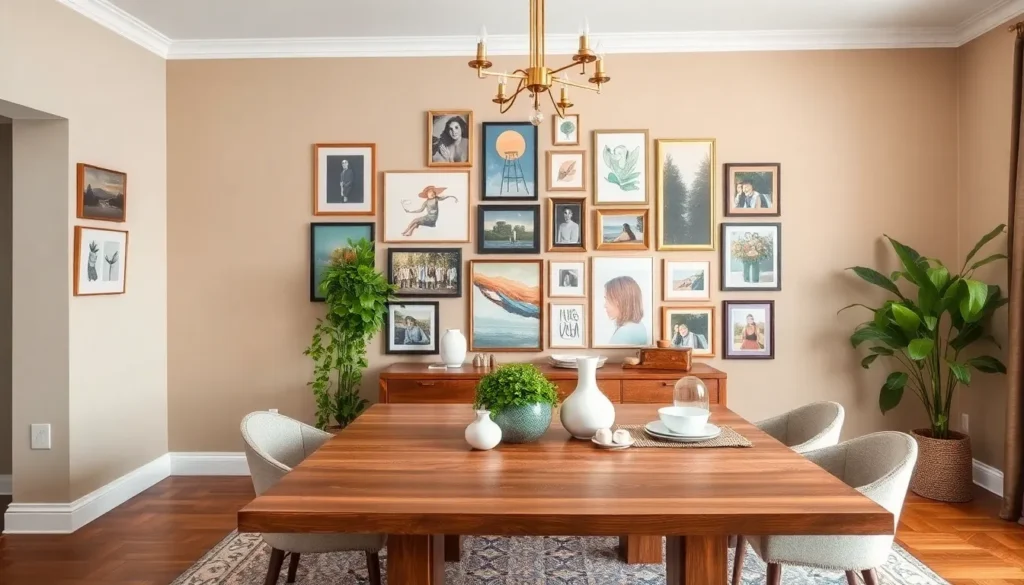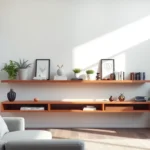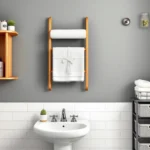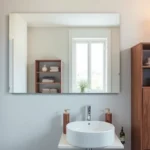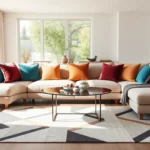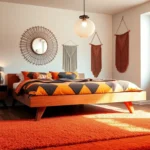We’ve all stood in our dining rooms wondering why the walls feel so… empty. That blank canvas staring back at us holds incredible potential to transform our space from basic to breathtaking. The right wall decor doesn’t just fill empty space – it creates atmosphere sets the mood and reflects our personal style.
Your dining room walls are prime real estate for making a statement. Whether you’re hosting intimate dinners or large family gatherings these surfaces can elevate every meal into a memorable experience. From classic gallery walls to bold accent pieces the possibilities are endless.
We’re here to guide you through the most impactful dining room wall decor ideas that’ll have your guests asking “where did you get that?” Transform your dining space into a room that’s not just functional but absolutely stunning with these creative answers that work for any budget or style preference.
Create a Stunning Gallery Wall With Mixed Artwork
Gallery walls transform dining room spaces into captivating focal points that showcase your personality while maintaining sophisticated elegance. We’ve discovered that mixing different types of artwork creates visual interest and depth that single large pieces simply can’t achieve.
Choose a Cohesive Color Palette
Select two to three dominant colors that complement your dining room’s existing decor scheme. We recommend pulling colors from your furniture, textiles, or architectural elements to ensure the gallery wall feels intentional rather than random.
Incorporate neutral tones like cream, gray, or black as anchor colors that tie diverse artwork together. These foundational shades allow bolder pieces to stand out while maintaining overall harmony across your dining room wall display.
Test color combinations by laying artwork on the floor before hanging to visualize how different pieces interact. We suggest photographing various arrangements to compare options and ensure your chosen palette enhances rather than competes with your dining room’s atmosphere.
Mix Different Frame Sizes and Styles
Combine large statement pieces with smaller complementary artwork to create ever-changing visual weight throughout your gallery wall. We’ve found that mixing 16×20 inch pieces with 8×10 inch and 5×7 inch frames creates perfect balance in most dining room spaces.
Vary frame materials between wood, metal, and painted finishes to add textural interest without overwhelming the display. Traditional black frames work beautifully alongside natural wood and brass accents to create sophisticated depth.
Arrange frames asymmetrically while maintaining visual balance through strategic placement of similar sized pieces. We recommend spacing frames 2 to 3 inches apart and using paper templates to plan your layout before making any holes in your dining room walls.
Include Personal Photos and Prints
Display family photographs alongside artistic prints to create emotional connection within your dining room gallery wall. We suggest using black and white family photos to maintain cohesion with colorful artwork while adding personal significance to your space.
Incorporate travel photography or meaningful prints that spark conversation during dinner gatherings. Restaurant scenes, food photography, or cultural artwork naturally complement dining room environments while reflecting your personal experiences and interests.
Balance personal elements with purchased artwork to avoid creating a purely sentimental display that lacks artistic merit. We recommend limiting personal photos to 30% of your total gallery wall to maintain sophisticated visual appeal while honoring cherished memories.
Install Statement Wallpaper for Bold Visual Impact

Statement wallpaper transforms dining rooms into dramatic spaces that captivate guests from the moment they enter. We’ve seen how this single design element creates instant sophistication while establishing a strong foundation for the rest of our decor choices.
Select Patterns That Complement Your Dining Style
Choosing the right pattern sets the tone for our entire dining experience. Formal dining rooms benefit from elegant designs like classic stripes or sophisticated florals that enhance traditional furnishings and crystal chandeliers. Modern spaces shine with geometric patterns or abstract designs that complement sleek furniture and contemporary lighting fixtures.
Traditional dining styles work beautifully with damask patterns, toile designs, or subtle botanical prints that create warmth without overwhelming the space. Eclectic dining rooms allow us to experiment with bold graphics, tropical motifs, or vintage inspired patterns that reflect our unique personality and design preferences.
Consider Accent Wall Placement
Strategic accent wall placement maximizes visual impact while maintaining balance throughout our dining room. We recommend focusing on the wall behind our dining table or buffet to create a natural focal point that draws attention to key furniture pieces. Windows with beautiful views benefit from accent walls on adjacent surfaces that frame the natural light without competing with outdoor scenery.
Architectural features like fireplaces or built in cabinets work perfectly as accent wall locations since they already serve as room anchors. Corner walls offer unexpected drama while allowing us to experiment with bolder patterns without overwhelming the entire space.
Balance Bold Patterns With Neutral Furnishings
Neutral furnishings provide the perfect counterbalance to dramatic wallpaper patterns. We achieve harmony by selecting dining chairs in solid colors like cream, beige, or soft gray that complement rather than compete with our statement wall. Table linens in neutral tones allow the wallpaper to remain the star while maintaining an elegant, cohesive look.
Lighting fixtures in brass, chrome, or matte black finishes ground bold patterns without adding visual noise. Area rugs in subtle textures or muted colors tie the room together while providing comfort underfoot during long dinner gatherings.
Add Dimension With Floating Shelves and Display Items

Floating shelves transform flat walls into ever-changing displays that add both function and visual appeal to your dining space. These versatile installations create depth while providing practical storage for decorative elements that reflect your personal style.
Style Shelves With Decorative Objects
Decorative objects bring personality and sophistication to your dining room shelves through carefully curated displays. We recommend arranging vintage pottery, fine china, or antique artifacts to create focal points that spark conversation during meals. Sculptural pieces like ceramic vases or metallic figurines add artistic flair while maintaining the elegant atmosphere your dining room deserves.
Grouping items in odd numbers creates visual balance and prevents the display from appearing too structured. Consider varying heights and textures by combining smooth ceramic pieces with rough stone sculptures or glossy metals with matte finishes. This approach ensures your shelving becomes a personalized gallery that enhances rather than overwhelms your dining experience.
Incorporate Plants and Greenery
Plants breathe life into dining room wall displays while purifying the air and creating a fresh, inviting atmosphere. We suggest hanging trailing plants like pothos or ivy from floating shelves to add movement and natural beauty to your space. Living walls or vertical gardens create stunning focal points that bring the outdoors inside.
Succulents work particularly well on dining room shelves because they require minimal maintenance and add texture without overwhelming the space. Air plants offer another low maintenance option that can be displayed in decorative holders or glass terrariums. These natural elements soften hard lines and create a welcoming environment that makes every meal feel special.
Mix Books and Personal Collections
Books combined with personal items create meaningful displays that tell your unique story while adding visual interest to dining room walls. We recommend mixing coffee table books about art, cuisine, or travel with family photos and cherished heirlooms to create conversation starters. This combination adds intellectual depth while maintaining the personal touch that makes your dining space feel like home.
Balance is key when incorporating personal collections alongside books on floating shelves. Consider displaying vintage serving pieces, inherited china, or travel souvenirs that complement your books without creating clutter. This thoughtful curation ensures your shelves become a reflection of your interests and experiences while maintaining the sophisticated atmosphere your dining room requires.
Incorporate Large-Scale Mirrors to Expand Your Space
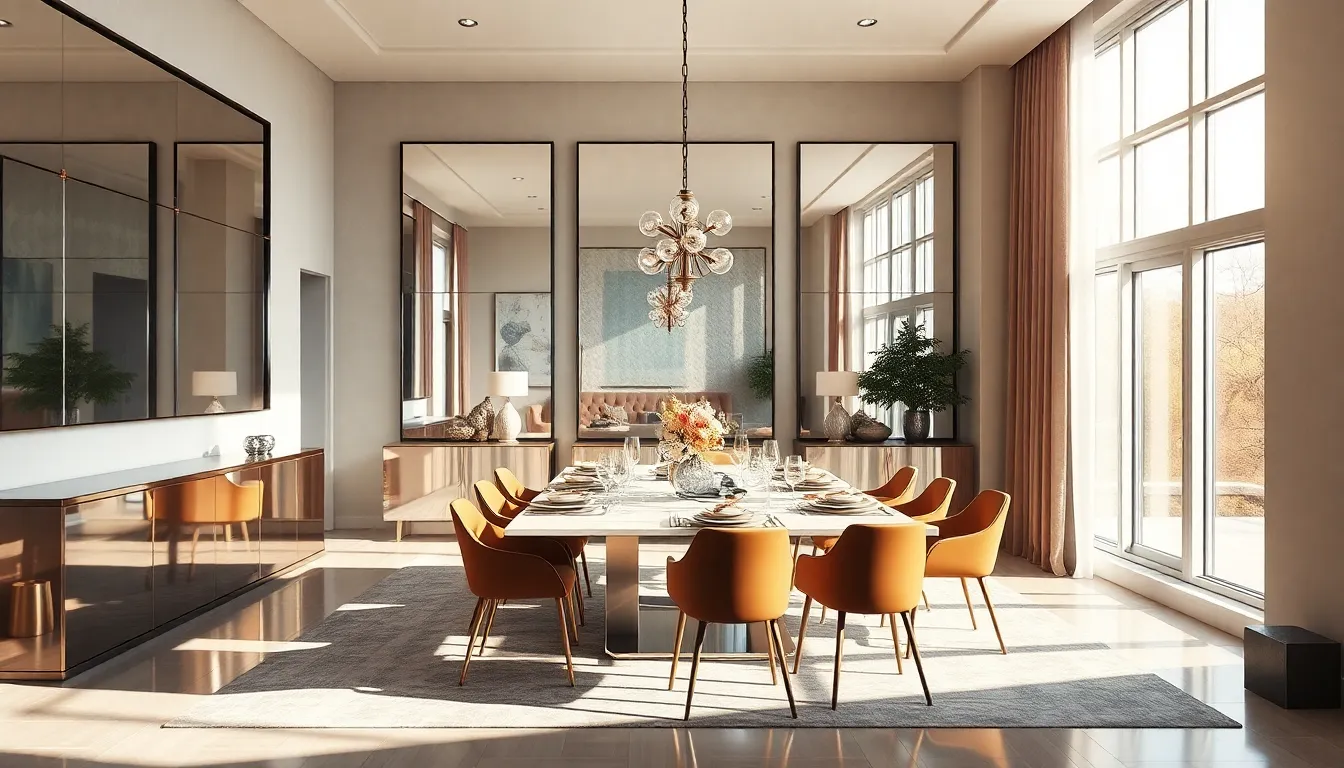
Large-scale mirrors transform dining room walls into powerful design elements that create the illusion of expanded space while adding sophisticated elegance. We’ll explore strategic mirror placement techniques that maximize both visual impact and functionality in your dining area.
Position Mirrors to Reflect Natural Light
Maximize brightness by placing mirrors directly opposite windows to reflect natural light throughout your dining room. This strategic positioning doubles the amount of light in the space, making it feel more open and inviting during daytime gatherings.
Create even light distribution by angling mirrors to bounce light into darker corners of the room. We recommend positioning a large horizontal mirror on the wall perpendicular to your main window to capture and redirect sunlight across the entire dining area.
Enhance golden hour ambiance by installing mirrors that catch late afternoon sun, creating warm, romantic lighting for evening meals. Consider placing mirrors at varying heights to capture light at different times of day, ensuring your dining room maintains its brightness from morning through evening.
Choose Frames That Match Your Decor Style
Match traditional decor with rectangular mirrors featuring simple, classic frames in wood or metal finishes. These timeless pieces complement formal dining rooms without overwhelming existing furniture or architectural details.
Add luxury touches through intricately framed mirrors that serve as statement pieces above your dining table. Ornate gold or silver frames work particularly well in elegant spaces, creating focal points that elevate the entire room’s sophistication level.
Soften modern aesthetics using round or oval mirrors that balance sharp lines in contemporary dining rooms. These curved shapes create visual relief against angular furniture and geometric patterns, adding warmth to minimalist spaces.
Coordinate with existing metals by selecting mirror frames that match your dining room’s hardware, light fixtures, or furniture accents. This cohesive approach ensures your mirrors feel intentionally integrated rather than randomly placed.
Use Multiple Mirrors for Added Drama
Layer varying sizes to create depth and visual interest across your dining room walls. We suggest combining one large statement mirror with two or three smaller complementary pieces, arranging them in asymmetrical groupings for ever-changing impact.
Accent exact areas by placing smaller mirrors near buffets, bar cabinets, or serving stations to highlight these functional zones. This technique draws attention to dining room features while adding sparkle and refinement to utilitarian spaces.
Create gallery wall effects using multiple mirrors in different shapes and frame styles for dramatic visual storytelling. Mix round, rectangular, and uniquely shaped mirrors to establish rhythm and movement across your wall space.
Enhance room dimensions through strategic mirror placement at varying heights and distances from each other. This layering technique makes dining rooms appear larger and more complex, giving guests multiple focal points to discover and enjoy.
Display Vintage or Antique Pieces for Character
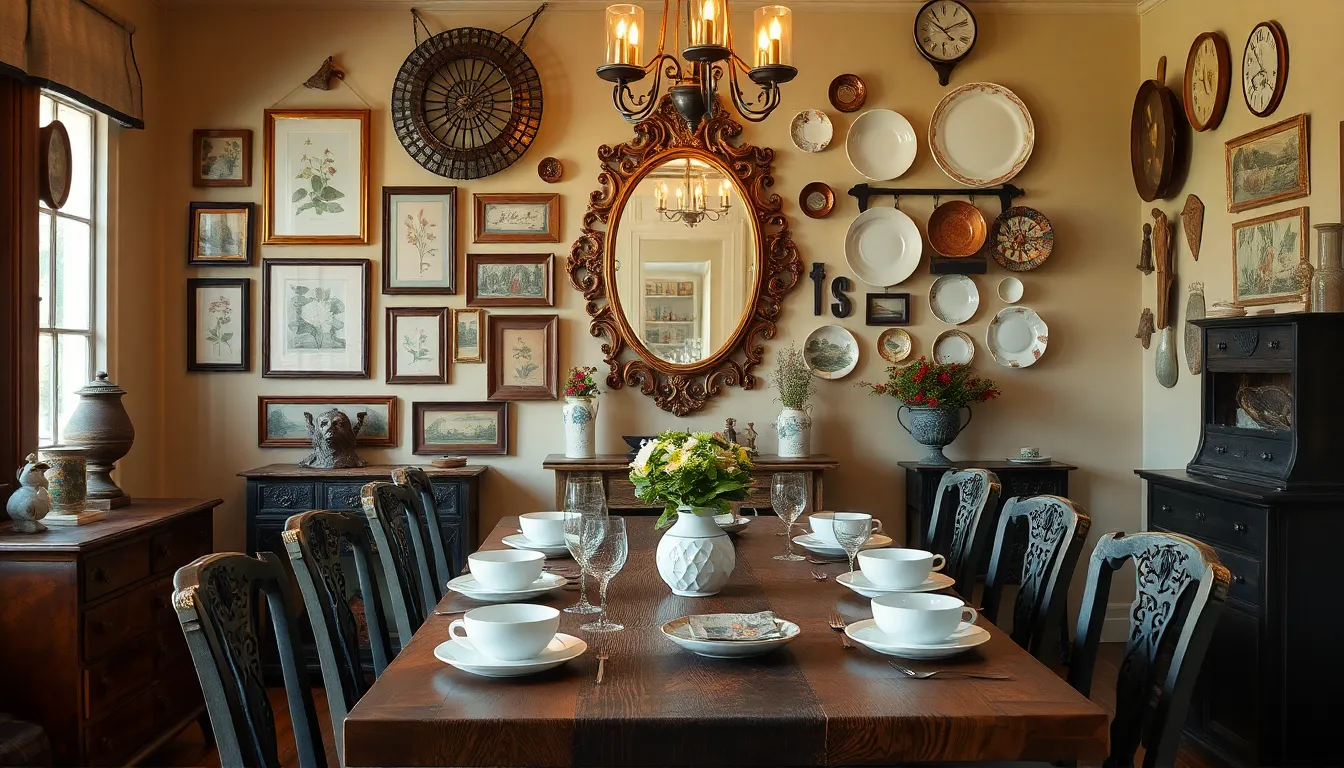
Adding vintage or antique pieces transforms dining room walls into storytelling canvases that reflect history and personal taste. These distinctive elements create conversation starters while establishing the room’s unique personality.
Hunt for Unique Finds at Flea Markets
Exploring flea markets opens up endless possibilities for discovering one-of-a-kind wall decor at reasonable costs. We find framed prints, retro kitchenware, and curious collectibles that can’t be replicated in retail stores. Vintage clocks serve as both functional timepieces and artistic focal points, while antique mirrors reflect light and expand visual space.
Searching through market stalls reveals hidden gems like old botanical prints, weathered signs, and ornate serving trays that make stunning wall displays. We recommend bringing measurements of your dining room walls to ensure proportional selections. Negotiating prices becomes easier when purchasing multiple pieces from the same vendor.
Incorporate Family Heirlooms
Displaying inherited pieces adds sentimental value and creates a welcoming atmosphere that connects generations. Family paintings, vintage photographs, and collectible plates tell our personal stories while enriching the room’s narrative. We arrange these treasures alongside other decor to create meaningful focal points that guests naturally gravitate toward.
Vintage dishes can be mounted on walls using plate hangers, transforming functional items into artistic displays. Photo collections work beautifully when grouped in vintage frames of varying sizes and finishes. Inherited textiles like antique quilts or embroidered pieces can be professionally framed to preserve their beauty while adding texture to walls.
Mix Old and New Elements
Blending traditional vintage pieces with contemporary elements creates ever-changing wall displays that feel both timeless and current. We pair antique chandeliers with modern wall art to achieve visual balance and prevent spaces from feeling dated. Reclaimed wood shelves support both vintage collectibles and contemporary decorative objects, bridging different design eras seamlessly.
Installing floating shelves beneath modern lighting fixtures provides flexible display options for mixing books, plants, and vintage curiosities. This approach allows us to rotate seasonal displays while maintaining core vintage elements. Strategic spacing and thoughtful placement ensure harmony between old and new pieces, creating depth and personality that reflects our evolving tastes.
Create Visual Interest With Textural Wall Elements
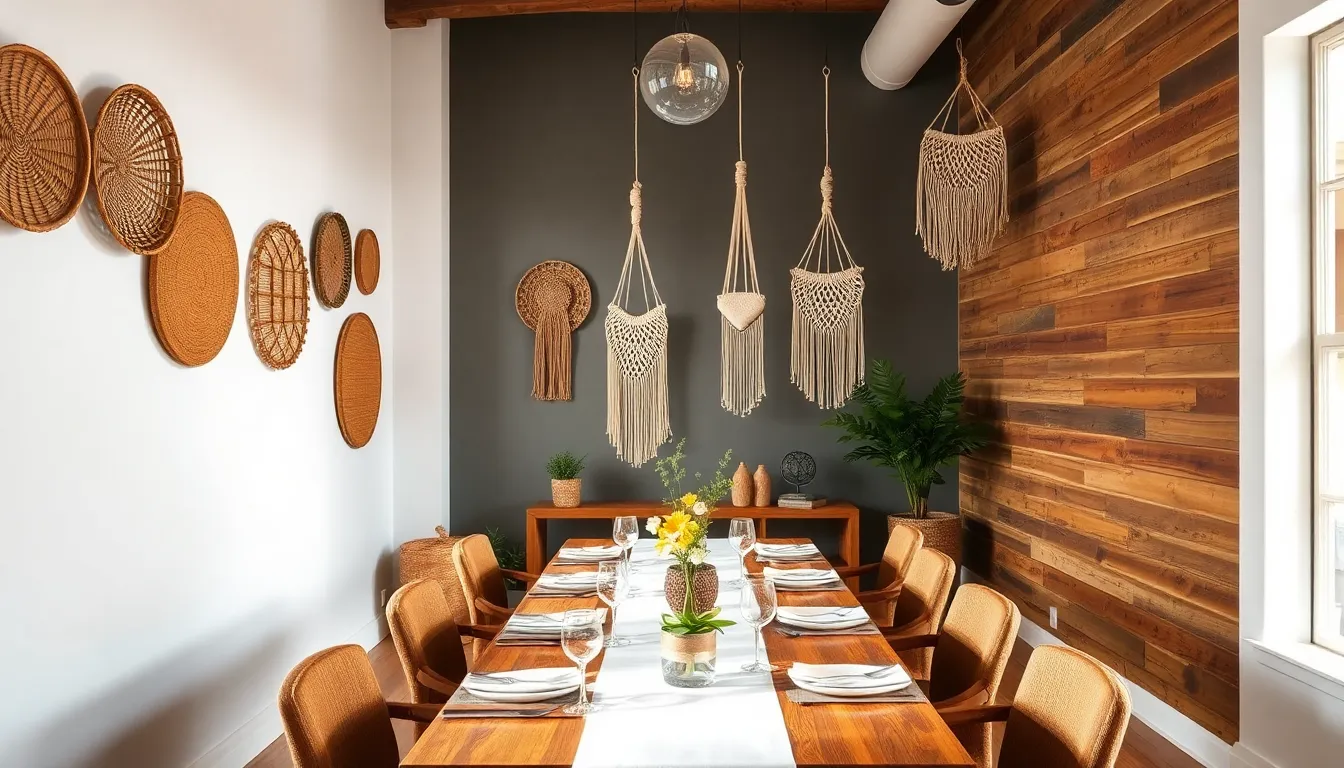
Textural elements transform flat dining room walls into ever-changing surfaces that engage our senses and create depth throughout the space.
Add Woven Baskets or Macrame
Woven baskets bring an organic warmth to dining room walls while introducing tactile interest that complements both rustic and modern aesthetics. We can arrange multiple baskets in varying sizes to create compelling focal points that draw the eye upward and add visual weight to empty wall spaces. Macrame wall hangings offer another excellent option for introducing soft texture, with their intricate knots and flowing designs adding movement and bohemian charm to formal dining areas.
Positioning these elements at eye level ensures maximum impact during meals and conversations. Natural fiber materials like jute, rattan, and cotton work particularly well because they introduce earthy tones that balance more structured furniture pieces. We recommend grouping odd numbers of baskets or selecting macrame pieces with varying lengths to create ever-changing arrangements that feel intentional rather than scattered.
Install Three-Dimensional Art Pieces
Three-dimensional artwork creates dramatic shadows and depth that flat pieces simply can’t achieve in dining room settings. Metal sculptures catch and reflect light throughout the day, adding sparkle and movement that enhances the dining experience. Glass art pieces introduce transparency and color while maintaining an elegant sophistication that works beautifully in formal spaces.
Mixed media installations allow us to combine different materials and textures for truly unique wall displays. Relief artwork pushes beyond traditional framing to create sculptural elements that serve as conversation starters during dinner parties. We suggest selecting pieces that complement our dining room’s scale, ensuring larger walls receive appropriately sized installations that command attention without overwhelming the space.
Use Natural Materials Like Wood or Stone
Wooden wall panels introduce warmth and organic beauty that softens formal dining rooms while adding architectural interest. Reclaimed wood brings character and history to our walls, with weathered textures and natural imperfections creating authentic focal points that tell stories. We can install horizontal planks for a modern farmhouse look or vertical boards to emphasize ceiling height and create more spacious feelings.
Stone accent walls provide substantial texture and earthy sophistication that anchors dining room designs. Natural stone tiles offer varied colors and patterns that create visual interest without requiring additional artwork or decor. Stacked stone installations add dimensional depth while maintaining neutral color palettes that complement existing furnishings. We recommend using stone elements strategically on single accent walls to avoid overwhelming the space while still achieving maximum textural impact.
Design a Focal Point With Statement Lighting
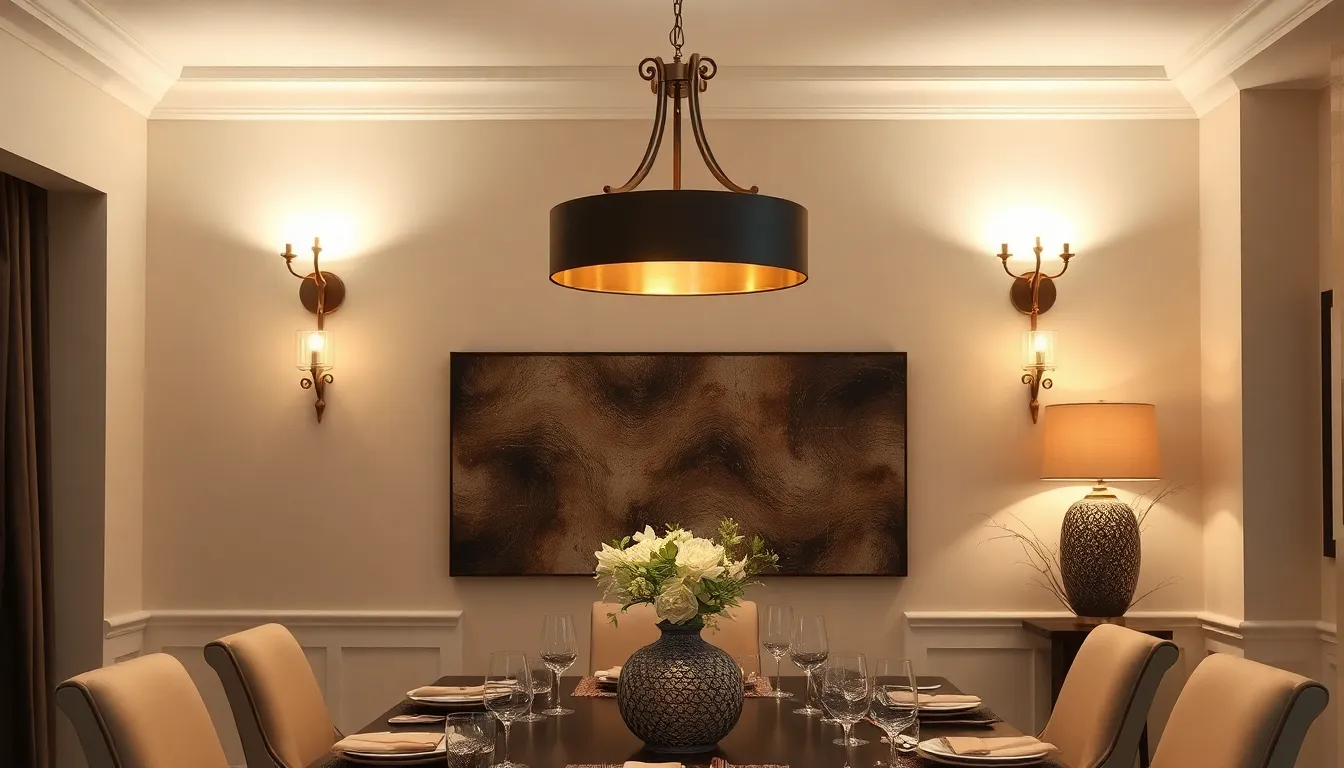
Lighting transforms dining room walls from mere surfaces into stunning visual centerpieces. We can achieve this transformation by selecting fixtures that serve as both functional illumination and striking decor elements.
Install Dramatic Sconces or Wall Lights
Wall mounted sconces add depth and dimension to our dining room walls while providing essential supplemental lighting. Modern or intricate designs create visual interest and contribute significantly to the overall decor scheme we’re building.
Rechargeable wireless wall sconces offer practical flexibility for our design plans. These fixtures allow easy installation without complex wiring and can be repositioned whenever we want to refresh our wall arrangement.
Strategic placement of these lights enhances architectural details we want to highlight. Positioning sconces at eye level creates warm pools of light that make our dining space feel more intimate and welcoming for guests.
Choose Fixtures That Double as Art
Decorative lamps serve as conversation starters while illuminating our dining room walls effectively. Sculptural sconces become focal points that guests naturally gravitate toward during dinner parties and gatherings.
Custom designed light pieces merge utility with aesthetic appeal seamlessly. These unique fixtures act as centerpieces that define our room’s character and reflect our personal design preferences.
Metallic finishes paired with neutral walls create sophisticated effects that elevate our entire dining experience. Selecting fixtures that complement or contrast with our existing color palette ensures a cohesive look throughout the space.
Layer Different Light Sources
Combining overhead lighting with wall lights creates versatility and comfort for various dining occasions. This approach allows us to control brightness levels and establish the perfect atmosphere for both casual meals and formal entertaining.
Accent lighting enhances artwork and architectural features we’ve carefully chosen for our walls. Table lamps can supplement our wall mounted fixtures to create balanced illumination throughout the dining area.
Ambient lighting ensures our space remains welcoming and functional for socializing after meals. Multiple light sources give us the flexibility to adjust the mood from bright task lighting to soft romantic ambiance as needed.
Use Wall Decals or Stencils for Custom Designs
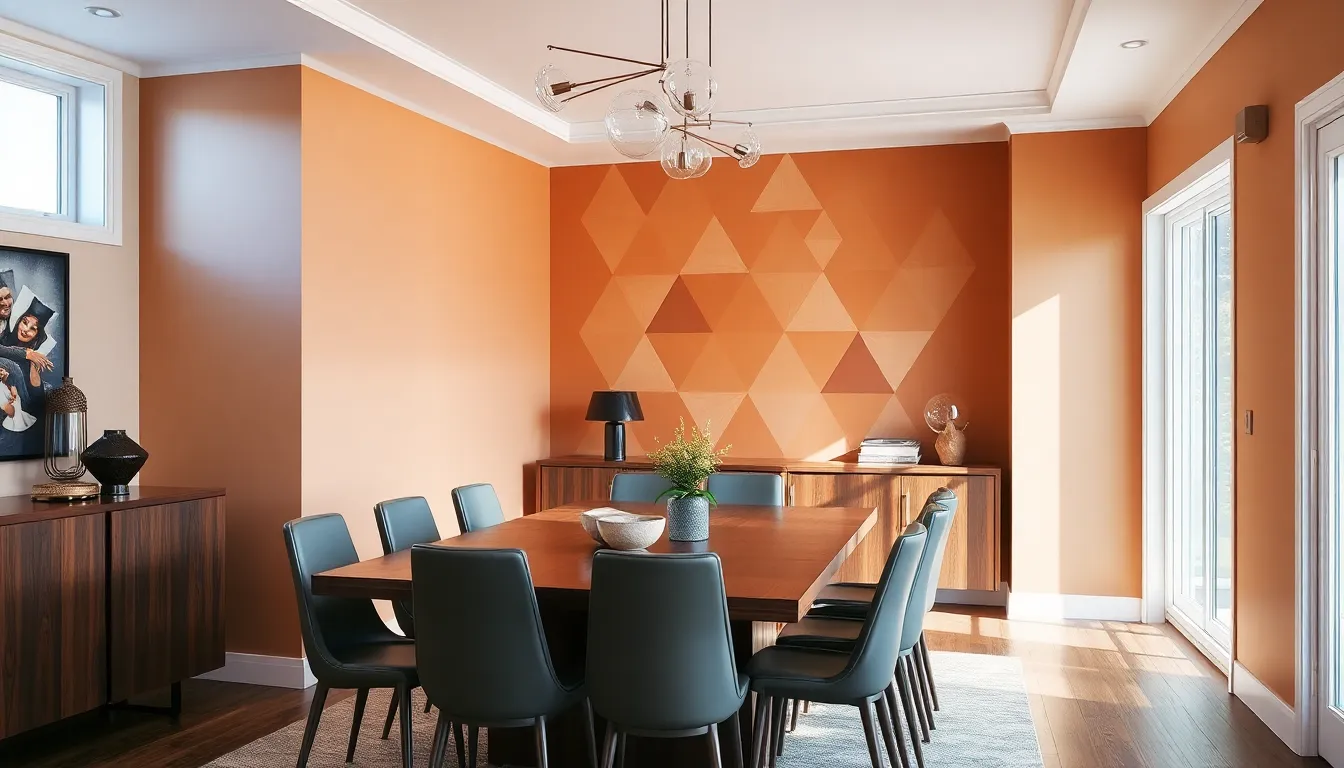
Wall decals and stencils offer an affordable way to transform your dining room walls with personalized designs. These versatile tools let us create stunning visual impact without the commitment of permanent changes.
Create Patterns That Reflect Your Style
Custom patterns allow us to express our personality while maintaining dining room sophistication. We can choose from geometric shapes, botanical motifs, or abstract designs that complement our existing color palette and furniture style. Stencils work particularly well for creating diamond shaped accent walls, where interlocking patterns add modern elegance to the space. Traditional dining rooms benefit from classic damask or floral stencils, while contemporary spaces shine with bold geometric or minimalist line patterns. We recommend testing pattern placement with painter’s tape before applying to ensure proper spacing and visual balance.
Apply Temporary Answers for Renters
Peel and stick decals provide the perfect solution for renters who want to personalize their dining spaces without losing security deposits. These removable options come in countless designs and can be repositioned multiple times during application for perfect placement. We suggest choosing high quality vinyl decals that won’t damage paint or leave residue when removed. Temporary stencils paired with washable paint markers offer another renter friendly approach to wall decoration. These answers allow us to experiment with different looks throughout our lease term, changing designs seasonally or when our style preferences evolve.
Incorporate Metallic Accents
Metallic stencils and decals add luxurious touches that elevate our dining room’s sophistication level. Gold accents work beautifully in warm toned spaces, while silver complements cool color schemes and modern decor. We can create dramatic black and gold accent walls using metallic stencils over dark base colors for a sophisticated ambiance perfect for entertaining. Copper and bronze metallic decals bring warmth to neutral dining rooms and pair exceptionally well with wood furniture and natural textures. Strategic placement of metallic elements near light sources enhances their reflective qualities, creating subtle shimmer that changes throughout the day.
Install Built-In or Floating Display Cases
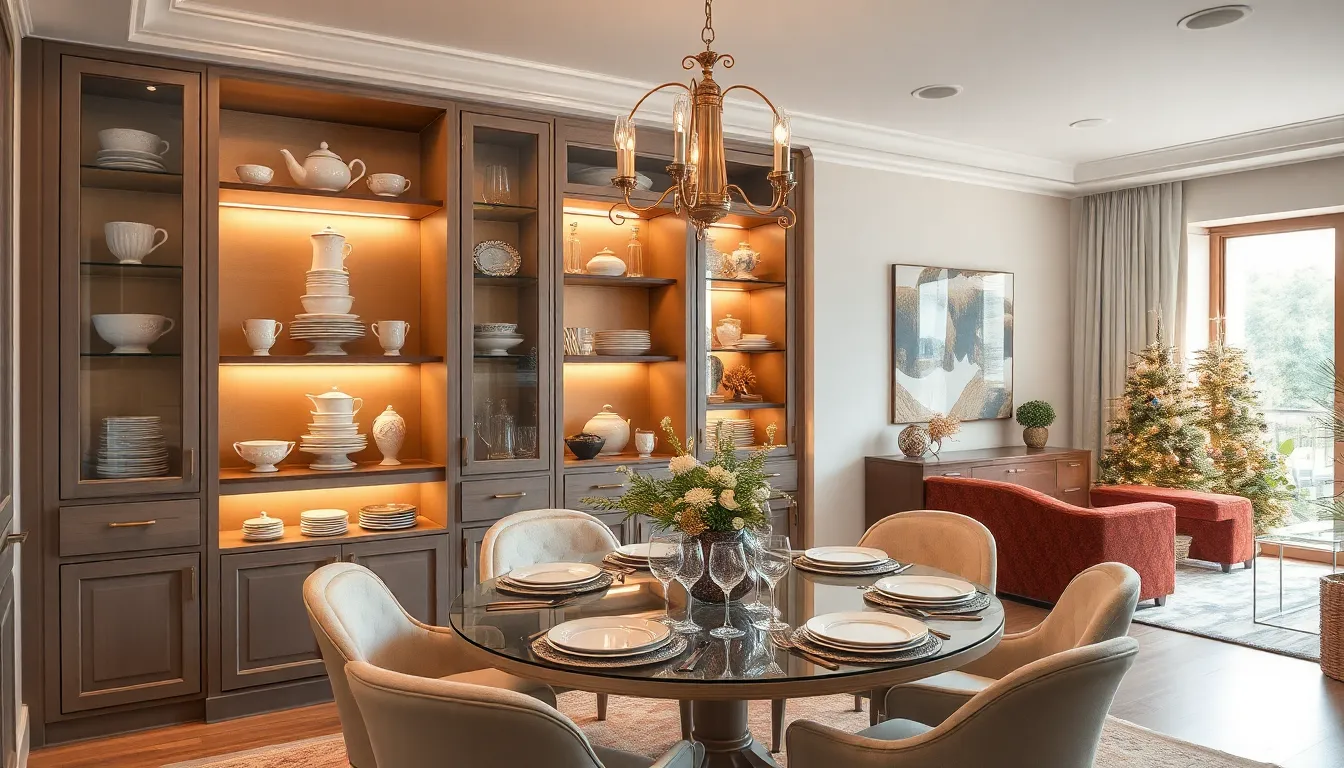
Built-in and floating display cases transform bare dining room walls into functional showcases that blend storage with style. These versatile answers offer endless possibilities for personalizing your space while maintaining clean, sophisticated lines.
Showcase Collectibles and Fine China
Curate your most treasured pieces by creating dedicated display areas that highlight your fine china, pottery collections, or family heirlooms. We recommend grouping similar items together while varying their heights and depths to create visual rhythm across your wall space.
Position delicate pieces at eye level where guests can appreciate their craftsmanship without overwhelming the room’s overall design. Your grandmother’s teacup collection or vintage serving platters become conversation starters when thoughtfully arranged on floating shelves.
Balance functionality with beauty by alternating everyday items with decorative pieces throughout your display cases. This approach ensures your storage remains practical while showcasing your personal style and creating meaningful focal points during dinner parties.
Add Interior Lighting for Drama
Install LED strip lighting inside built-in cases to illuminate your displays and create stunning visual depth along your dining room walls. These energy-efficient options provide consistent, warm illumination that enhances the beauty of glass, ceramic, and metallic pieces.
Position adjustable spotlights above floating shelves to highlight exact collections and cast dramatic shadows that add dimension to your wall displays. We suggest using warm white bulbs (2700K-3000K) to complement your dining room’s intimate atmosphere.
Layer different lighting sources by combining interior case lighting with ambient room lighting to create versatile moods throughout the day. Evening meals become more elegant when your display cases glow softly while overhead fixtures provide general illumination.
Create Seasonal Display Opportunities
Rotate decorative elements throughout the year to keep your dining room feeling fresh and festive without major renovations. We recommend dedicating exact shelves to seasonal items like autumn gourds, winter holiday decorations, or spring botanicals.
Establish permanent anchor pieces that remain consistent while swapping out 30-40% of your displayed items seasonally. This strategy maintains visual continuity while allowing your space to reflect current seasons and celebrations.
Plan storage answers for off-season items by incorporating hidden compartments within built-in cases or designating lower shelves for rotating inventory. Your dining room stays organized while offering flexibility to celebrate holidays and special occasions with appropriate wall decor.
Hang Textile Art and Fabric Pieces
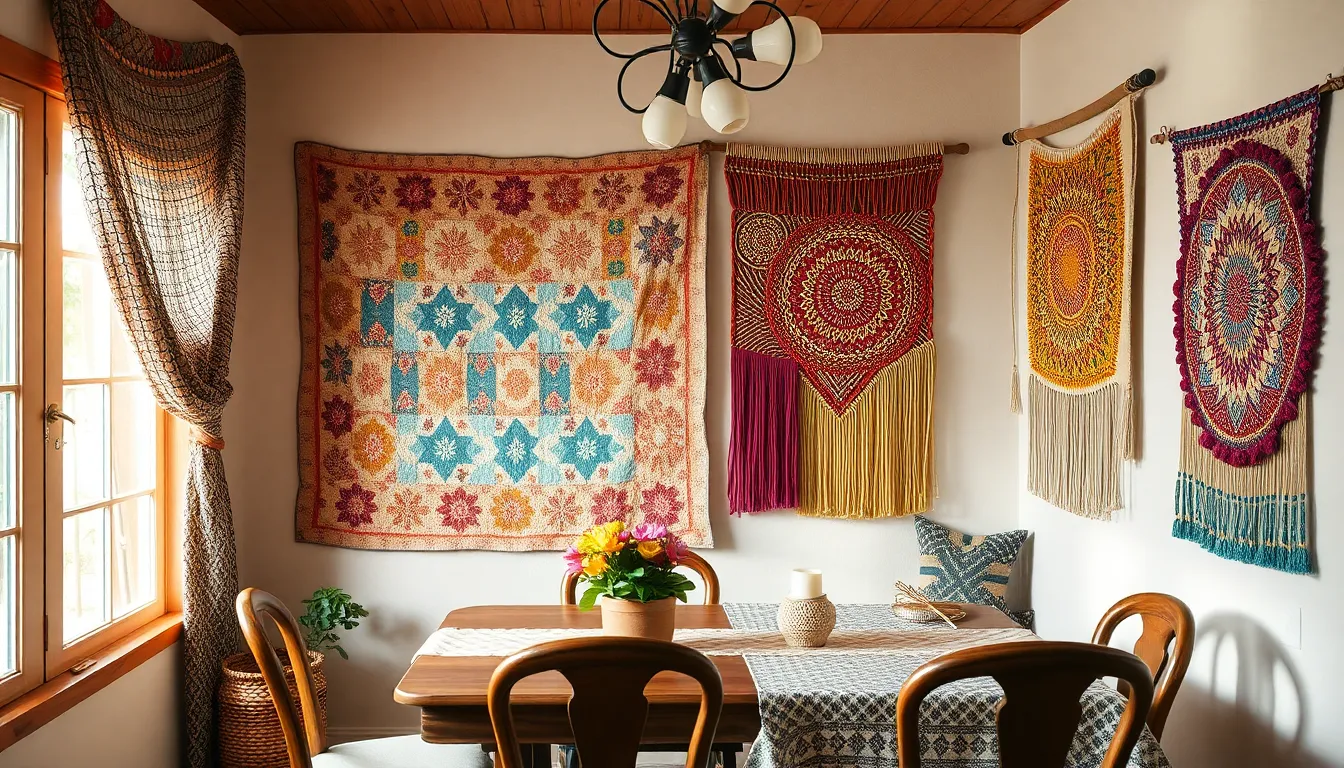
Textile art transforms dining room walls by introducing rich textures and dimensional interest that photos and paintings simply can’t achieve. Fabric pieces create an inviting atmosphere that makes guests feel welcomed while adding sophisticated layers to your decor scheme.
Display Vintage Quilts or Tapestries
Vintage quilts bring centuries of craftsmanship and storytelling to your dining room walls. These heirloom pieces often feature intricate patterns like log cabin designs, wedding ring motifs, or geometric star formations that serve as stunning focal points. We recommend mounting quilts using museum-quality hanging systems to preserve their integrity while showcasing their beauty.
Tapestries offer another elegant option for adding historical charm to your space. Medieval-inspired pieces, Persian designs, or Art Nouveau tapestries can complement various dining room styles from traditional to eclectic. Position these textile treasures on walls where they won’t be exposed to direct sunlight to prevent fading and deterioration.
European antique tapestries particularly excel at creating dramatic backdrops behind dining tables. Their rich colors and detailed imagery spark conversation while establishing an atmosphere of refined elegance that enhances every meal.
Add Warmth With Woven Wall Hangings
Woven wall hangings crafted from velvet, linen, or burlap instantly warm up dining spaces with their tactile appeal. These pieces range from simple macramé designs to elaborate fiber art installations that command attention without overwhelming the room. Natural materials like jute and cotton create organic textures that soften hard surfaces and architectural lines.
Contemporary woven pieces work beautifully in modern dining rooms where their geometric patterns and neutral tones complement sleek furniture. Bohemian-style hangings with fringe details and earth tones suit casual dining spaces perfectly. We suggest grouping smaller woven pieces together to create gallery wall effects that maximize visual impact.
Handmade fiber art pieces add artisanal character that mass-produced wall decor cannot match. These unique creations often incorporate mixed materials like wood beads, metal accents, or colorful yarns that create depth and visual interest throughout your dining area.
Incorporate Cultural Textile Elements
Cultural textile elements enrich dining rooms by celebrating diverse artistic traditions and personal heritage. African diaspora textiles, Asian silk panels, and Latin American weavings introduce vibrant colors and meaningful patterns that reflect global craftsmanship. These pieces honor cultural artistry while creating personalized spaces that tell your unique story.
Handcrafted pieces from various cultures offer authentic alternatives to mass-produced wall art. Kente cloth from Ghana, Andean textiles from Peru, or Japanese indigo fabrics each bring distinct aesthetic qualities and cultural significance to your dining environment. We recommend researching the origins and meanings behind these textiles to appreciate their full cultural value.
Mixing cultural elements requires thoughtful curation to avoid cultural appropriation while celebrating artistic diversity. Choose pieces that resonate with your personal experiences or family heritage, and display them with respect for their origins and significance. This approach creates meaningful wall displays that spark conversations about art, culture, and personal connections.
Conclusion
Your dining room walls offer endless opportunities to showcase your personal style while creating an inviting atmosphere for memorable gatherings. From gallery walls and statement wallpaper to floating shelves and vintage treasures each approach we’ve explored can transform your space into something truly special.
The key lies in finding the perfect balance between functionality and visual appeal. Whether you’re drawn to dramatic lighting fixtures textural elements or carefully curated display cases the most successful dining rooms combine multiple approaches that work harmoniously together.
Remember that the best wall decor reflects your unique personality while improving the overall dining experience. Start with one focal point and gradually layer additional elements to create a space that feels both sophisticated and authentically yours.
Frequently Asked Questions
What are the best ways to create a cohesive gallery wall in my dining room?
Choose 2-3 dominant colors that complement your existing decor and incorporate neutral tones to tie everything together. Mix different frame sizes and styles for visual interest, and arrange them asymmetrically for a dynamic look. Include personal photos alongside artistic prints, but limit personal elements to 30% of the display to maintain sophistication.
How do I choose the right wallpaper pattern for my dining room?
Consider your dining room’s style and formality level. Elegant designs work well in formal spaces, while geometric or abstract patterns suit modern areas. Focus on patterns that enhance rather than overwhelm your dining experience, and ensure they complement your existing furniture and decor elements.
Where should I place an accent wall with bold wallpaper?
The most impactful locations are behind the dining table or adjacent to windows. These strategic placements maximize visual impact and create natural focal points. Avoid placing bold wallpaper on all walls, as this can overwhelm the space and make it feel cramped.
How can I balance bold wallpaper without overwhelming my dining room?
Use neutral furnishings and decor elements to create balance. Choose solid-colored dining chairs, subtle area rugs, and simple window treatments. This approach allows your statement wallpaper to be the star while maintaining overall harmony and elegance in the space.
What’s the best way to style floating shelves in a dining room?
Arrange decorative objects in odd numbers for visual balance, incorporating items like vintage pottery and sculptural pieces. Add plants and greenery for freshness, and mix books with personal collections. Keep displays meaningful but sophisticated, ensuring items reflect your personal story while maintaining aesthetic appeal.
How do mirrors help enhance a dining room’s appearance?
Large-scale mirrors expand the visual space and add elegance to dining rooms. Place them opposite windows to reflect natural light and brighten the room. Mirrors also create warm ambiance during evening meals and can be layered in varying sizes for added drama and visual interest.
Where can I find unique vintage pieces for my dining room walls?
Flea markets, antique shops, and estate sales are excellent sources for one-of-a-kind vintage decor. Look for items that serve as conversation starters and complement your existing style. Don’t overlook family heirlooms, which add sentimental value and connect generations while creating meaningful wall displays.
What types of textural elements work well on dining room walls?
Woven baskets, macrame, and natural materials like wood and stone add depth and warmth. Three-dimensional art pieces create dramatic shadows and visual interest. Arrange these elements at eye level for maximum impact, and choose pieces appropriately sized for your dining room’s scale.
How can statement lighting transform my dining room walls?
Dramatic sconces and wall lights add depth, dimension, and essential illumination. Choose fixtures that double as art, such as sculptural sconces, which serve as conversation starters. Layer different light sources including overhead and accent lighting to create a versatile, inviting atmosphere that enhances architectural details.
What should I display in built-in or floating display cases?
Curate collectibles and fine china, balancing functional items with decorative pieces. Add interior LED lighting to illuminate displays and create visual depth. Rotate seasonal decorative elements throughout the year while maintaining a consistent aesthetic. This approach transforms bare walls into functional showcases that reflect your personal style.
How do I incorporate textile art without overwhelming my dining room?
Choose pieces like vintage quilts, tapestries, or woven wall hangings that add warmth and texture. Use museum-quality hanging systems for preservation, especially with valuable textiles. Focus on handmade fiber art and cultural elements that celebrate artistic traditions, but curate thoughtfully to maintain balance and avoid cultural appropriation.

